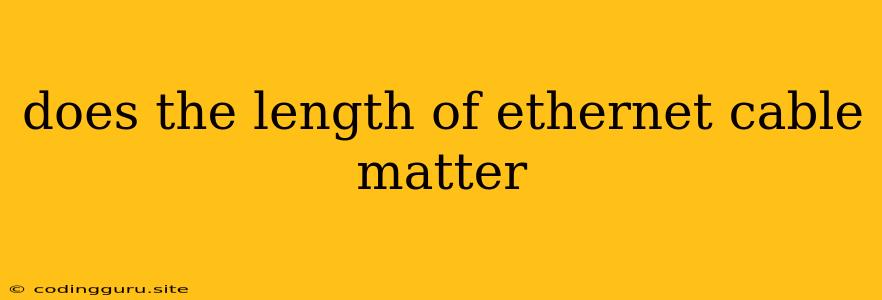Does the Length of Ethernet Cable Matter?
The length of your Ethernet cable can certainly impact your internet connection, but it's not always a simple yes or no answer. It depends on several factors, including the type of Ethernet cable you're using, the speed you need, and the distance between your devices. Let's explore some key considerations.
Understanding Ethernet Cable Types and Speed Limits
The type of Ethernet cable you use directly affects the maximum distance it can effectively carry data. Here's a breakdown:
- Cat 5e: This standard cable can handle speeds up to 1 Gigabit per second (Gbps) and is suitable for distances up to 100 meters (328 feet).
- Cat 6: Cat 6 cables offer improved performance, handling speeds up to 10 Gbps and distances of up to 55 meters (180 feet).
- Cat 6a: This type provides even greater performance, reaching speeds up to 10 Gbps with a maximum distance of 100 meters (328 feet).
- Cat 7: Cat 7 cables are designed for 10 Gbps speeds and can support distances up to 100 meters (328 feet).
Important: While these are general guidelines, it's always best to consult the manufacturer's specifications for your specific cable.
What Happens When You Exceed the Limits?
When you use an Ethernet cable that's too long for its specified category and speed, you can experience several issues:
- Reduced Speed: The signal weakens over longer distances, leading to slower data transfer rates. You might notice your internet browsing or downloads becoming sluggish.
- Intermittent Connection: Weak signals can result in intermittent connection drops. Your internet connection might repeatedly connect and disconnect, frustrating your online activities.
- No Connection: In some cases, the signal might weaken so much that it doesn't even reach the destination device, resulting in a complete lack of internet connectivity.
Tips for Optimizing Ethernet Cable Length
- Know your needs: Assess the distance between your devices and determine the required speed for your application. Choose a cable category that meets both distance and speed requirements.
- Shorter is often better: While exceeding the maximum distance is problematic, even staying within the recommended range can sometimes lead to signal degradation. For optimal performance, try to use the shortest cable possible while still connecting your devices.
- Consider alternatives for long distances: If you need to connect devices over distances exceeding the maximum limits of standard Ethernet cables, consider using a network switch or extenders. These devices can amplify and extend the signal, enabling reliable connections across longer distances.
- Invest in quality: Avoid cheap cables, as they might not meet the advertised specifications. Opt for high-quality cables from reputable brands to ensure consistent performance and longevity.
Conclusion
While the length of your Ethernet cable may seem like a minor detail, it can significantly impact your internet experience. By understanding the different cable types, speed limitations, and optimization techniques, you can choose the appropriate cable length and ensure reliable connectivity for your devices. Remember to prioritize quality cables and keep your distances within the specified limits to enjoy fast and stable internet access.
